Sprinkler Systems
Water-based fire suppression
Steve Emery
 |
||
| The fire at the Royal Clarence Hotel, Exeter in 2016 – one of several disasters over the past few years to highlight the need for more effective systems of fire protection in historic buildings. (Photo: Apex News and Pictures Agency/Alamy Stock Photo) |
Owners and occupiers of listed buildings are encouraged by heritage organisations to improve their fire protection and fire prevention measures to reduce the number and severity of accidental fires that have destroyed some of our best loved historic buildings over the years. In some situations the most effective form of protection may be an automatic suppression system delivering water via sprinkler heads which are activated by the heat of a fire. However, the provision of suppression systems in heritage buildings is an emotive subject, with enthusiasts calling for all heritage buildings to be fitted with sprinklers, and with opponents horrified about introducing a flood risk.
There may be a large choice of fire safety solutions available to improve the ‘fire performance’ of a building, which is how it will behave when it catches fire. When making decisions, the following questions should be considered:
- What factors pose the biggest threats to the building when it is involved in fire?
- Can these threats be reduced to an acceptable level that does not involve any upgrading, such as reducing the fire load, or changing to a lower risk activity?
- If improvements are necessary, are they designed to minimise or avoid harm to the things which make
the historic building special? - Will the improvements be effective? For instance, a fire alarm system not linked to an alarm receiving centre will not provide any protection when the building is unoccupied.
- Will the improvements be affordable and if not is there a more cost effective alternative?
- Will any improvements, particularly passive measures such as upgrading the fire compartments be robust enough to withstand the passage of time as well as an attack by fire?
- Is the level of proposed improvements commensurate with the risk?
For instance, the fire performance of a brickbuilt railway arch will be far better than a five-storey wooden mill. The railway arch may require just the provision of a fire extinguisher, while the mill may benefit from the installation of an automatic fire suppression system.
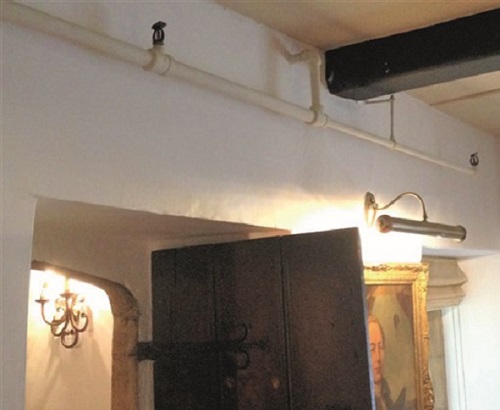 |
 |
| Lygon arms sprinklers in lieu of fire doors. (Photos: Steve Emery unless otherwise stated) | Simple sprinkler on copper pipe, Norway. |
AUTOMATIC SUPPRESSION SYSTEMS
The fitting of automatic fire suppression systems such as sprinklers is not a new solution and the oldest fire sprinkler system in the world is believed to be one in the Grade I listed Theatre Royal in Drury Lane, London. Dating back to 1812, it is itself of great historic significance in the development of fire protection systems, which over the years have evolved to encompass high and low pressure water mist systems.
There will sometimes be advantages to using a fire suppression system as part of a fire engineering solution, to avoid other fire protection measures which may be more damaging to the things which make the historic building special.
Doors, for example, can provide an enhanced degree of fire protection if kept cool by being sprayed with water. Suitably located sprinkler heads can thus assist in allowing original fittings to be left in place, and the maintenance of the original fabric of a building. A sprinkler system can also compensate for the inadequacies of the building structure to resist fire. In some cases the installation of sprinklers can be a critical factor in maintaining the original layout and use of a historic building, and hence preserving its historical and cultural significance.
The Lygon Arms in Broadway has a preworld war two fire sprinkler system (illustrated above), which has enabled the hotel to retain its existing doors and wooden ceilings despite the advent of the Fire Precautions Act 1971 and Fire Safety Order 2005.
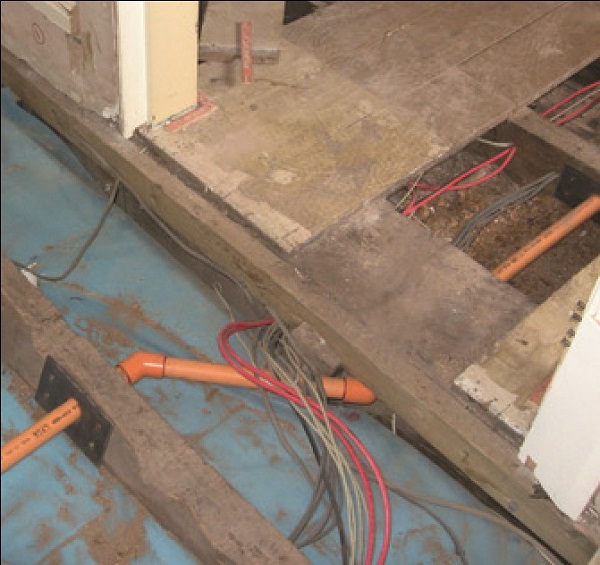 |
||
| CPVC sprinkler pipe with PVC cables laid across it. |
An automatic sprinkler system consists of a series of sprinkler heads, positioned normally at ceiling or roof level or at a high level on a wall, connected by pipework to a water supply via a control valve system. The general operation of an automatic sprinkler system is that the sprinkler heads react to heat from a fire beneath them and automatically release water onto the fire. Only the sprinkler heads above or adjacent to the fire will operate initially, releasing water onto the fire and wetting the area immediately surrounding it. Statistics reveal that 26 per cent of fires in buildings in which sprinklers are installed are controlled by the opening of a single head.
Water is discharged from a sprinkler head at a rate of between 30 and 100 litres per minute. This compares with about 350 litres per minute from a hand-held fire brigade hose and about 1,700 litres per minute from a monitor operated from a hydraulic platform or turntable ladder. If a fire is allowed to develop, considerably greater quantities of water would therefore be used by the fire brigade to extinguish it.
It has been claimed that the accidental failure rate for a sprinkler head is one in 16 million, so the possibility of damage being caused by one of the heads going off accidentally is very low. However, leaks from pipework are not included in these statistics, so concerns raised over the possibility of accidental damage to historic fabric have not been assuaged. Incidents involving water in heritage buildings from all sources are estimated to be nine times more common than fire incidents.
SYSTEM DESIGN
Generally the pipes used for water sprinkler systems have been made of durable steel or copper which are arguably the most reliable options when fitting them in historic buildings. A commonly used alternative is a durable type of rigid plastic, CPVC. However, there are some types of CPVC pipes in use that can be prone to catastrophic failure which makes them unsuitable for certain historic buildings, such as those with fine ornamental ceilings or historic collections. The failures can be caused by a number of situations that cause physical or chemical weaknesses, such as:
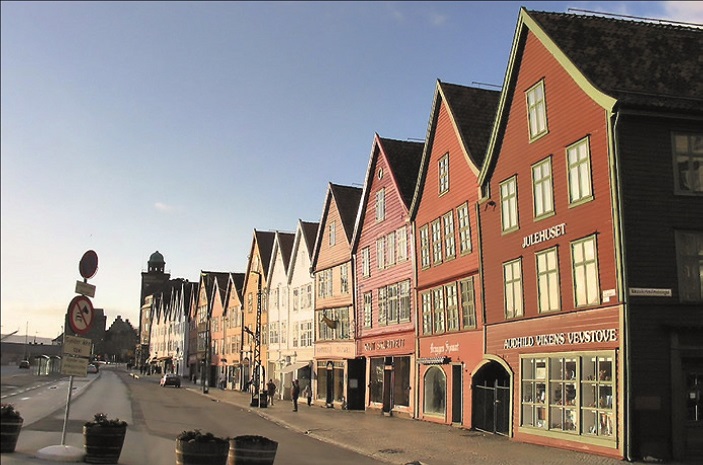 |
||
| Sprinkler protection of roofs in Bergen: the exposed pipework is filled with pressurised air, and water rises only when a bulb is broken. |
- dropping the pipes during delivery
- storing the pipes in sunlight
- standing on the pipes before fitting or when in situ
- spraying fly killer or hairspray on the pipes
- having PVC electrical cables touching the pipe (illustrated above)
- incorrect gluing of the joints – joints must be turned by 90 degrees when glued.
This is particularly relevant when commissioning because the pressure testing is undertaken with water rather than air.
There are two types of water fire suppression systems, automatic sprinklers and water mist. The British standard for sprinkler systems is BSEN 12845, but there are also Loss Prevention Council Rules and Technical Bulletins, which are authorised by the Fire Protection Association. This organisation acts on behalf of the insurance industry, so their rules should be followed if the requirement for sprinklers is insurance led. Water mist systems in domestic buildings are covered by BS 8458 while BS 8489 Part 1 sets out the design criteria for non-domestic buildings. However, unlike the sprinkler standard, BS 8489’s suitability for a particular fire risk is dependent on there being an acceptable test protocol. If there is no evidence of suitability for a particular application, then a specific protocol will have to be developed for the proposed use.
There is a division between advocates of each type of system, with some insurance companies insisting on sprinkler protection in certain situations and being totally against water mist systems. There is no preference by contractors who fit these systems.
The benefits of domestic water mist systems was confirmed in 2006 when Cheshire fire and rescue service compared the efficiency of a low pressure water mist system with a domestic sprinkler system in a pair of condemned semi-detached houses.
 |
|
| External protection of jettied timbers and recessed wall, Bergen. | |
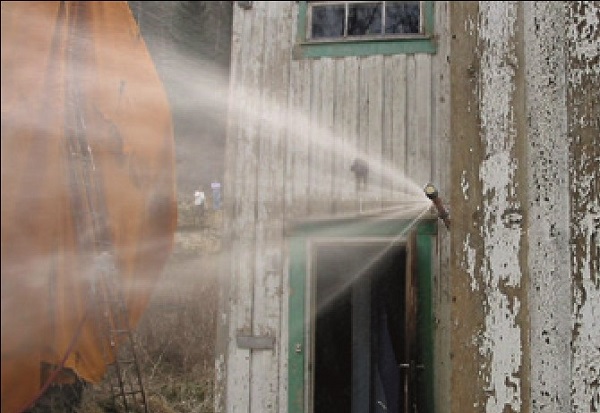 |
|
| A Fogtube spray in Norway which delivers water supplied by the fire service, allowing all the pipework to be kept dry. |
At the time the Domestic Sprinkler Association claimed that water mist would not work if the windows or doors were open because the mist would escape from the room on fire. It was found that both systems were similarly effective, but in the fully ventilated room, when sprinklers operated, the expansion of the water into steam created a pressure that drove the smoke up the staircase. The water mist used less water, which equated to much less steam. The water mist also entrained smoke back toward the fire, which needed oxygen, rather than allowing it to spread up the staircase. This made escape down the staircase from the upper floor possible.
Sprinkler systems in historic buildings should be designed with great care to fully respect the historic building fabric. This means that each system will have to be precisely engineered in order to be acceptable, both in terms of avoiding unnecessary damage to the fabric and also in terms of its appearance (illustrated top right). The reason for the fitting of a suppression system must be well understood, so that the protection afforded is as expected by the designer.
A sympathetic approach to fitting modern technology to a historic building can be seen at Schönbrunn Palace in Vienna, where all services are contained in a pole. These include an electrical socket, emergency light, speaker and a sprinkler head.
When considering the provision of sprinkler protection in a building it should be remembered that, while sprinklers are very effective at controlling fires, they will have no influence over whether or not ignition takes place. The presence of sprinkler protection does not eliminate the need for preventative measures to reduce the risk of a fire occurring.
Sprinkler protection is very advanced in Scandinavian countries, where wooden buildings predominate. Following the serious fire that spread to a number of wooden merchant houses in Bergen in the 1950s, the remaining houses were fitted with internal and external sprinklers to prevent fires from spreading to their neighbours.
It can be seen that with these external systems the sprinkler heads are upright, which allows the pipework to be drained during the winter to prevent freezing. The pipes are then pressurised with air and when a bulb is broken by heat the air is expelled allowing the water to flow. If the pipes are kept dry all year round it is called a dry system and if it is wet during the summer it is called an alternate system.
Because of the temperature extremes in Norway, they have developed a dry pipe water mist system called Fogtube where the water is supplied by fire engines. The Fogtube has an inlet for the fire service hose and 15mm copper tubes are fixed in the loft. The tube has two slits cut into it at 45 degrees to each other, so water emerging from them creates a mist that has a mixture of droplet sizes. A fire test was carried out just north of Trondheim in 2004 which proved the system’s effectiveness. A wooden farmhouse was fitted with a Fogtube in the loft, and holes were formed in the ceilings of the lounge and bedroom to allow the fire to spread vertically. A fire was lit in the lounge and reached flashover, then spread to the bedroom which also reached flashover but it was prevented from entering the loft by the water mist. This proved the theory that the loft would remain intact while the rest of the house burnt down.
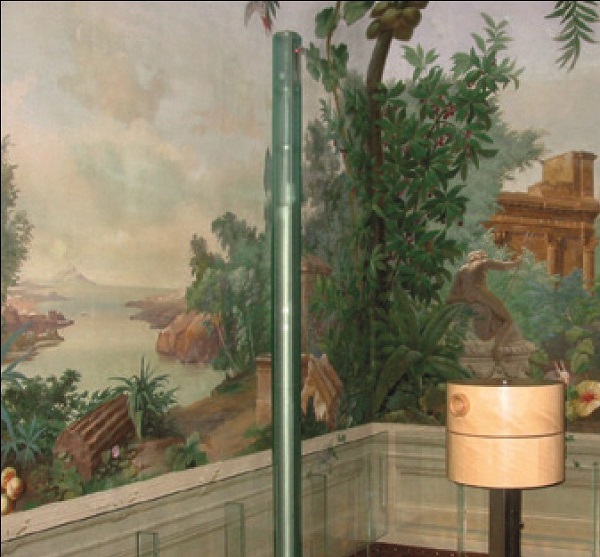 |
||
| A pole in Schönbrunn Palace in Vienna combining sprinkler, emergency lighting and other services. |
Dry systems like this may also be appropriate for heritage buildings where the risk of accidental leakage is the principal deterrent. However, the ability of a sprinkler system to respond automatically and control a fire is of particular importance in rural areas where the building may be far from the nearest fire station, which will lead to some delay in firefighting operations being commenced by the brigade. Some of the fire stations may be manned by retained (part time) fire crews, which typically results in a delay when compared with stations manned by full time staff. Also, if the retained crew were already responding to a fire situation the call would have to go to a fire station further afield.
A sprinkler system is not intended to cope with a fully developed fire which may enter the sprinkler protected area from an adjacent part of the building with no system in place. Therefore, if sprinklers are to be installed, they should ideally be installed throughout the whole of the building in question. If installed selectively, as can happen in an historic building, physical barriers to control the spread of fire into the sprinkler protected compartment would be required. In such cases the sprinkler system would be designed to protect the room or compartment of origin.
The cost of installing a sprinkler system in an historic building varies depending on the type and size of the building, its form of construction and use, its location, the type of sprinkler system to be installed, and the ease of access to areas in which pipes and sprinkler heads are to be installed.
The cost of sprinklers is often compared to the cost of a good quality carpet, but this does not take into account the pumps and tanks, nor the additional costs that arise in occupied buildings where furnishings and fittings have to be moved and stored. In heritage buildings with historic collections this is a specialist operation requiring careful documentation, handling and storage, and skilled conservators may be required for the lifting and reinstatement of floor boards and other historic fabric. This could be four times the cost of the system itself. It will be more economical and less disruptive to the fabric of the building if the installation of sprinklers can be carried out at the same time as other services are being renewed.
If an organisation has a number of buildings it would not be feasible to fit sprinklers to all of them, but prioritising the requirement is problematic. Should the one which is most vulnerable come first, or the one with the highest insured value? As with all issues connected with fire prevention and protection, the key is to understand the risks.



